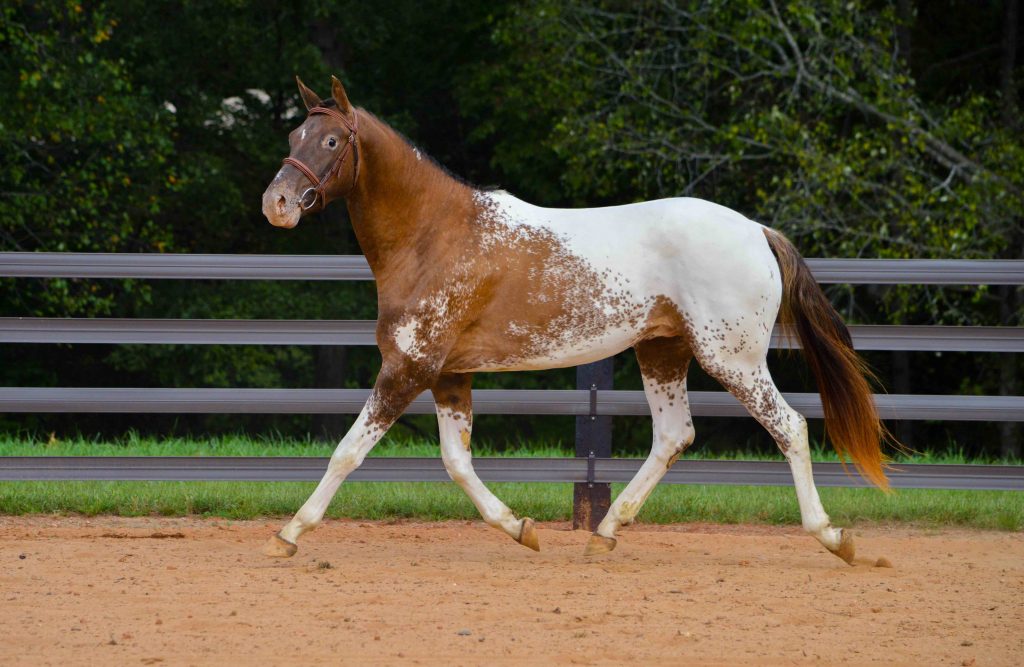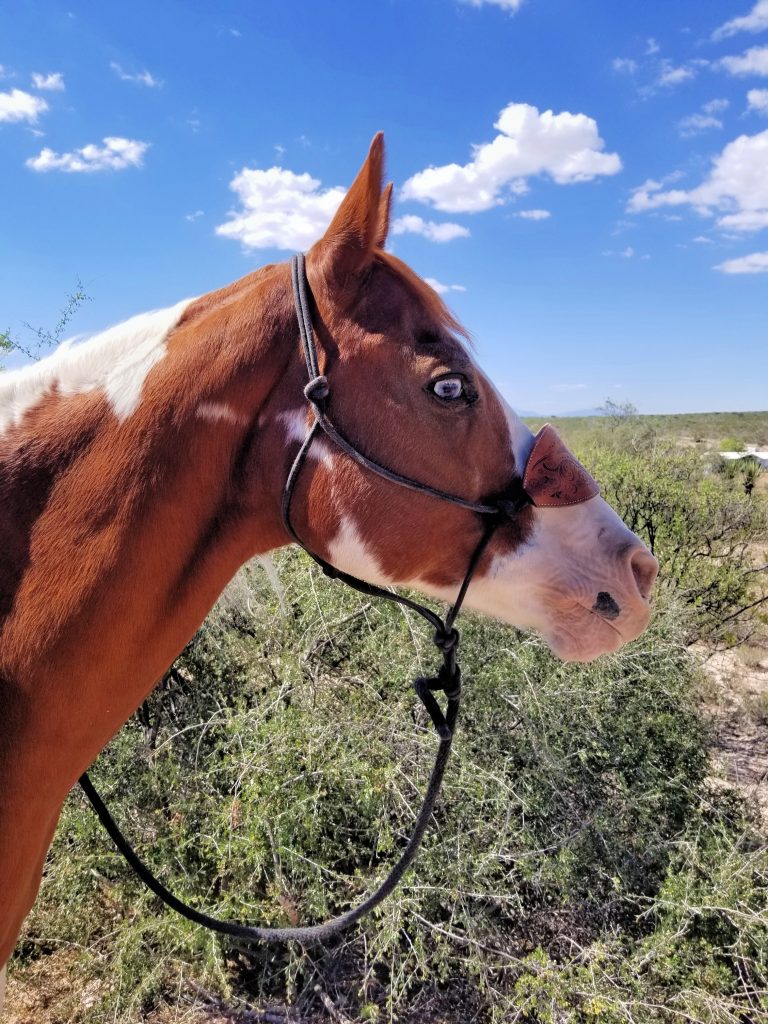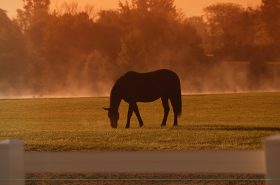Remember your grade school art class? You learned that the primary colors; red, yellow, and blue were the source of all other colors. Secondary colors; orange, green, and violet come from mixing two primary colors adjacent to each other on the color wheel. Suddenly, your plain blue skies could look quite stormy!
Pretty exciting stuff. Not only, did you gain access to all the colors of the rainbow, but you now had a vague idea of how they’d arrived on the page. Your teacher reminded you that no matter what colors you created, the primary colors remained constant.
Equine color genetics follow similar rules, but because we’re talking genetics, there are a few wild cards thrown in for good measure. Breeders consider those wild cards part of the thrill in breeding color horses. The element of surprise keeps life interesting.
DNA
With the exception of monozygotic twins (identical), every living being on earth has its own unique genetic pattern. Forget about money; your genes are your ultimate inheritance. Your genes determine everything from hair color to quirky behavioral traits, yet you’ll never see them up close and personal even under the most sophisticated microscope.
What we can see is our DNA, a ‘blueprint’ we can pass on to our offspring. Our DNA carries our genetic information inside cells that are neatly packaged in chromosomes. With me so far? Okay, the chromosome, (really just a long, continuous piece of DNA) is visible under a microscope and this is how scientists can determine what makes your Palomino golden or your Appaloosa spotted.
If you breed color horses, you’ll know a thing or two about genetics already. DNA codings occupy a specific position on the chromosome and that position, known as a locus, determines the message it carries. This group of DNA (sort of like a friendly gang) is called an ‘allele’ [ə´lēl]. Every organism boasts two alleles for every biological trait. When the allele for a specific trait, like curly hair is heterozygous, one allele is
considered dominant and the other recessive. When the allele pair is identical, the trait is known as homozygous.
Primary Colors
Equine color breeding, of course, is not an exact science. Quite the opposite, in fact. Just like our grade school art class, we start with the basics. Black and chestnut are the equine version of the primary colors. All horse colors, from Appaloosas to Pintos, have a base coat of either black or chestnut, with splashy colors thrown in regardless of how they may appear to the human eye.
Color geneticists know to ignore the white when determining the color of a horse. This is because the primary color, (black or chestnut), is what gives the horse his ‘base coat’. Any white markings we see are the result of a separate gene that is whitewashed over the original base color. Large patchy white markings, like the ones we see in Paint Horses, Pintos, and Appaloosas hide the base color of the gene. On the other hand, white hairs that mingle with the black or chestnut base color create the effect we see in roans and sabinos.
What about all the colors in between? Dilute genes, like cream, champagne, dun, and silver are dominant genes that simply dilute the original base color, giving us a variety of shades like the ones we see in the Palomino. In order for a foal to be a Palomino, dun, silver dapple, or grulla, he must have at least one parent with a dominant dilute gene.
So, although a ‘renegade’ Palomino or dun foal will occasionally surprise a breeder, (especially when it seems to have come from ‘nowhere’), at least one parent must have carried the dilute gene in order to produce it. The dilute gene doesn’t affect all color pigments and therefore can lie dormant for generations before suddenly appearing in a newborn foal.
Color modifiers are genes that will darken, lighten or otherwise change the base color. Examples of this can be seen on some Haflinger horses, where the base coat (chestnut) appears to be a light tan or gray behind the elbows, under the belly, or around the muzzle. A good example of a color-modifying gene is seen on the Exmoor pony. These ponies have what is known as a ‘mealy mouth’; a gray or brown shading around the muzzle.
Color modifiers are also evident in horses like Belgians and Haflingers. These breeds are not palomino in color at all, though many people think so. What’s the difference between a palomino and a chestnut colored horse? Every cream or palomino-colored horse carries at least one chestnut gene and one dilute gene. It’s the dilute gene that gives him his cream or palomino coloring.
Chestnut horses, on the other hand, carry two chestnut genes and if bred together will always reproduce chestnut. That’s why the Haflinger horse always reproduces in color.
In Living Color, the Buckskin, Dun, and Grulla
Buckskin, dun, and grulla colored horses are found in a variety of breeds, including Icelandics, Miniature horses, Spanish Mustangs, and, of course, the American Quarter Horse. The Norwegian Fjord is exclusively a dun-colored horse, while the Thoroughbred and the Arabian don’t seem to have any dun colored horses at all.
The only way a foal can be a genetic dun is to have at least one genetically dun parent. Keep in mind that the dilute gene for this color can and will dilute both black and red base colors. This gives us the rainbow of shades, from ‘bay-dun’ to red-dun to a lovely silvery-dun.
Paint By Number, The Various Shades of the Pinto and Paint Horse.
The Pinto Horse Association of America recognizes two colors, the tobiano and the overo pattern. According to the registry, “the tobiano appears to be white with large splotches of color. Spots of color typically originate from the head, chest, flank, and buttock, often including the tail. Generally, the white crosses the back or topline of the horse. It is believed to be necessary to have at least one tobiano parent to produce a tobiano foal.”
“Overo appears to be a colored horse with jagged white markings usually originating on the animal’s side or belly, spreading towards the neck, tail, legs, and back. The color appears to frame the white spots, thus an overo often has a dark tail, mane, legs, and backline.” Bald or white faces are common.
Crop-out overos, or foals born to parents of solid colors, are often a mystery to breeders. It is believed that the overo gene may actually be dominant and not recessive as previously thought.
On the Spot; Appaloosas, Knabstruppers, Pony of the Americas, and the Colorado Ranger Horse.
The spotted coloring we normally associate with the Appaloosa horse also shows up in the Knabstrupper, the Miniature Horse, Pony of the Americas, the Colorado Ranger Horse, Spanish Mustangs, and even the tiny Falabella. Dr. Phillip Sponenberg, equine color geneticist, called this color type, the “Leopard Complex”, theorizing that all these spotted patterns were somehow related to each other.
Horses with the Leopard Complex normally possess other genetic traits such as mottled skin on the lips, nostrils, and around the eyes, a white sclera, and striped hooves. The patterns of the coats are beautiful and varied from a cheerful snowflake pattern to a varnished red roan and will often change dramatically as the horse matures.
Of course, a good horse is never a bad color. Responsible breeders always breed for conformation, performance, and temperament first, but…hey…a little splash of color sure is fun!
**Karen Elizabeth Baril writes for both regional and national publications, including EQUUS Magazine, The Equine Journal, InfoHorse.com, and Animal Wellness. Follow her at www.karenelizabethbaril.com or on Linked In.







